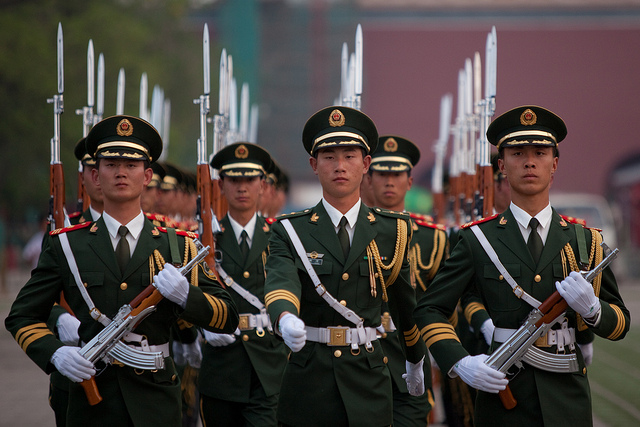Marching in China's boots
Posted By
Mike Scrafton
on April 4, 2016 @ 11:00

Imagine yourself walking down the long corridor to the briefing room of the Chinese Central Military Commission (CMC). What would it be like to be providing strategic policy advice to the Chinese government? What would it be like to employ the principles that inform Australian strategic policy, applying them to China’s situation?
Every Australian Defence White Paper since 1976 has begun it’s analysis with a geographic appreciation. As the 1987 White paper put it, ‘More fundamentally, our geographic location and the lack of land borders, combine to provide us with natural defences against conventional attack’. The 1994 White Paper surmised, ‘Within the priorities shaped by Australia's strategic geography, the defence posture and capabilities we need are determined by the nature and level of opposing capabilities which might credibly confront us’.
Consistent with that guidance the 2000 White Paper was adamant that:
‘Australia's most basic strategic interest remains the defence of Australia against direct armed attack. This includes armed attacks by other states and by non-state actors with the capacity to employ strategic capabilities, including weapons of mass destruction (WMD). This most basic strategic interest abides irrespective of the perceived intentions of others, and is a function of our geography and levels of current and future capability in the region around us. Before we attend to anything else, we must secure this strategic interest’.
The 2009 White Paper said, ‘Defence planning must have regard not just to the intentions of others who might be able to affect our strategic interests, but to capability as well’. In 2013 the White Paper announced that, ‘Denying an adversary our air and sea approaches in the archipelago is vitally important for deterring and defeating attacks on Australian territory’.
In summary, strategic advice provided to the CMC based on Australian strategic policy principles would emphasise the implications of China’s geography and the level of capability in the region. These facts would drive a force posture and military strategy for China that was shaped by the priority strategic need of deterring or defeating an attack on China.
However, China isn’t an island continent. In fact, China has both land borders and maritime approaches—making the strategic equation more difficult. Like Australia, China is a large country with the overwhelming bulk of the population in the Eastern coastal regions. Unlike Australia, the archipelago from which attacks could be launched across the East and South China Seas and the Sea of Japan against China’s population and industrial centres is proximate.
What of the level of capability in China’s region of maritime strategic interest? An indicative, but crude, measure of military capability is defence expenditure. The regional major powers in China’s East Asian theatre—Japan, South Korea, Taiwan and Australia—collectively spent approximately 70 percent of China’s budget in 2015. However, I would be forced to point out in my advice that as recently as 2000 these nations collectively spent three times the amount on defence as China. That is, their aggregate investment in Defence over past decades is greater than China’s.
In addition, China’s land neighbours also spent collectively the equivalent of two thirds of China’s defence budget on their militaries. The existence of contiguous land borders with significant military powers greatly complicates China’s strategic calculus when viewed in light of the Australian principle of regarding capability not intent. Among China’s 14 contiguous neighbours are four nuclear powers. An important consideration for the CMC would be that while China has 260 nuclear warheads, Russia has 7,500, India 90-110, Pakistan 100-120, and North Korea 6-8. China’s land neighbours also have large standing armies – including 845,000 in Russia, 1,330,000 in India, 643,000 in Pakistan and in North Korea 1,190,000.
Finally, an overwhelming fact would be obvious to the CMC. The conventional and nuclear capability of the US dwarfs that of both our maritime and land neighbours and its power projection capabilities are peerless and will remain so for the foreseeable future.
Consistent with the Australian approach to strategic policy, the CMC would weigh the military capabilities of its neighbors and the US and not to base their decision making on the aggressive anti-Chinese rhetoric that can be found among the political elites in nations like Japan, Australia and the US. Nor should the CMC be over confident in growing relationships with Russia, Pakistan and Central Asia. Only geography and capability matter.
Such an analysis should persuade the CMC to maintain or increase Defence spending within fiscal realities and to maintain a forward posture in the South China Sea consistent with China’s ‘basic strategic interest’ to defend against ‘direct armed attack’.
At the very least, the CMC would appreciate that at least Australia understood China’s strategic reasoning.
Mike Scrafton is a former senior defence executive, CEO of a State Statutory Body and chief of staff and ministerial adviser to a former Minister for Defence.
Article printed from The Strategist: https://www.aspistrategist.org.au
URL to article: https://www.aspistrategist.org.au/marching-in-chinas-boots-2/
[1] 1987 White paper: http://www.defence.gov.au/Publications/wpaper1987.pdf
[2] 1994 White Paper: http://www.defence.gov.au/Publications/wpaper1994.pdf
[3] 2000 White Paper: http://www.defence.gov.au/publications/wpaper2000.pdf
[4] 2009 White Paper: http://www.defence.gov.au/whitepaper/2009/
[5] White Paper: http://www.defence.gov.au/whitepaper/2013/
[6] defence expenditure: http://www.globalfirepower.com/countries-listing-asia-pacific.asp
[7] nuclear warheads: http://www.sipri.org/research/armaments/nuclear-forces
[8] large standing armies: http://www.mapsofworld.com/world-top-ten/world-top-ten-countries-with-largest-armies-map.html
 Print This Post
Print This Post